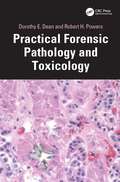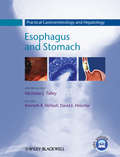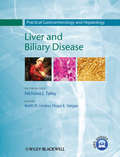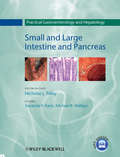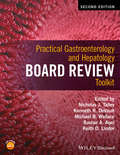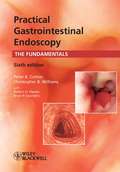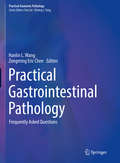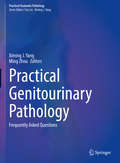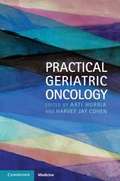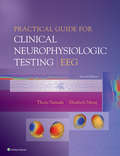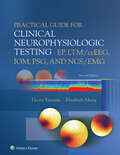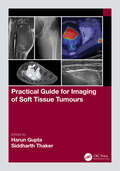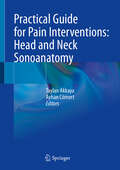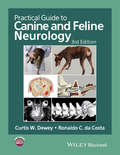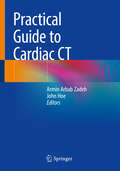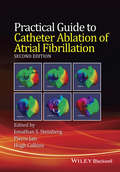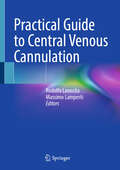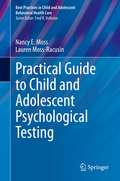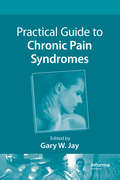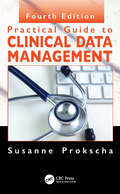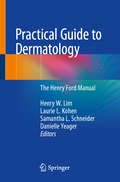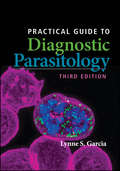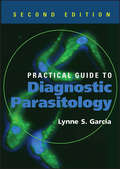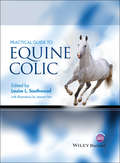- Table View
- List View
Practical Forensic Pathology and Toxicology
by Robert H. Powers Dorothy E. DeanPractical Forensic Pathology and Toxicology is a companion to the authors’ original book on the subject, Forensic Toxicology: Mechanisms and Pathology. This new volume addresses issues that forensic pathologists face when confronted by the suspected or demonstrated presence of drugs or toxins in their cases. Since such considerations include the need for a basic understanding of the direct physiological effects of potentially toxic agents, the authors highlight various connections and interaction between forensic pathology and toxicology. The book is written for both the practicing pathologist, and those in training, who may already have some knowledge of forensic medicine but are on occasion faced with issues that reach beyond a basic determination of cause and manner of death.Pathologists are expected to provide informed, well‑reasoned opinions explaining how a person died—which includes questions about any drugs, prescription medications, or otherwise that may have caused or contributed to death. As such, this book looks at the direct physiological effects of drugs and toxins, answering questions such as “Why does hypernatremia cause seizures?” or “Why can synthetic cannabinoids cause fatal complications, yet THC does not?” or the very timely “What is the mechanism by which an opiate overdose causes death?” Coverage primarily centers on the pathological derangements and physiological consequences of the actions of drugs and toxins, and the cellular mechanisms by which those pathological consequences arise.Organized using an organ system approach, sections are divided into major target organ systems and sections included for affected organs and tissues. While some drugs affect more than one organ system—and some patients will have multiple drugs present—the book’s categorization and organization take this approach to be readily usable for the reader. Case reports are included with additional patient data to show the effects of specific toxins and poisons both alone and in combination with natural disease. Color figures illustrate all aspects of drug or toxin impact on postmortem casework including the scene of death, the deceased persons, and the organs and tissues affected.Practical Forensic Pathology and Toxicology is an invaluable resource for practicing pathologists, toxicologists, and those training for those fields. It also serves as a useful reference for lawyers, judges, insurance companies, and other medical professionals who need to know, in light of what drugs are present in a particular case, what such compounds do, and how their presence (or absence thereof) is—or is not—related to an individual’s death.
Practical Functional Urology
by John Heesakkers Christopher Chapple Dirk De Ridder Fawzy FaragFunctional urology is that part of urological practice which deals with functional disorders of the lower urinary tract. Among the diseases that cause functional disorders are spina bifida, spinal cord injury, pelvic organ prolapse, and urethral strictures. This book on practical functional urology will help urologists, urogynecologists, and others to diagnose and treat these functional disorders. The theoretical background and scientific basis are summarized, but the emphasis is very much on clinical practice. Diagnosis and treatment are presented for a variety of conditions, including overactive bladder, detrusor underactivity, painful bladder syndrome/interstitial cystitis, prostatitis, stress urinary incontinence, pelvic organ prolapse, urinary tract infections, and urethral disorders. The content is based on the EAU guidelines, and for each disorder, helpful tips and tricks are highlighted.
Practical Gastroenterology and Hepatology
by Nicholas J. Talley Kenneth R. Devault David E. FleischerThis comprehensive resource for fellows/trainees and candidates for recertification in gastroenterology summarizes the field in a modern, fresh format. Prominent experts from around the globe write on their areas of expertise, and each chapter follows a uniform structure. The focus is on key knowledge, with the most important clinical facts highlighted in boxes. Color illustrations reinforce the text.
Practical Gastroenterology and Hepatology
by Nicholas J. Talley Hugo E. Vargas Keith D. LindorThis comprehensive resource for fellows/trainees and candidates for recertification in gastroenterology summarizes the field in a modern, fresh format. Prominent experts from around the globe write on their areas of expertise, and each chapter follows a uniform structure. The focus is on key knowledge, with the most important clinical facts highlighted in boxes. Color illustrations reinforce the text.
Practical Gastroenterology and Hepatology
by Nicholas J. Talley Sunanda V. Kane Michael B. WallaceThis comprehensive resource for fellows/trainees and candidates for recertification in gastroenterology summarizes the field in a modern, fresh format. Prominent experts from around the globe write on their areas of expertise, and each chapter follows a uniform structure. The focus is on key knowledge, with the most important clinical facts highlighted in boxes. Color illustrations reinforce the text.
Practical Gastroenterology and Hepatology Board Review Toolkit
by Nicholas J. Talley Kenneth R. Devault Michael B. Wallace Keith D. Lindor Bashar A. AqelPacked with Board-focused hints, case studies and an online Board-standard MCQ test offering CME credits, this fantastic book covers every gastroenterology disease and symptom you're likely to encounter and is the perfect tool to prepare for Board exams and certification.
Practical Gastrointestinal Endoscopy: The Fundamentals
by Peter B. Cotton Christopher B. WilliamsPractical Gastrointestinal Endoscopy has become the basic primer for endoscopy around the world. This new edition has been thoroughly revised and updated. Drawing on the vast experience of the authors it provides clear and practical guidance on the fundamentals of standard endoscopy practice. It describes procedures in great depth and addresses improved therapeutic techniques and advances in technology. The book is well illustrated throughout with color line drawings and diagrams. It is an indispensable resource for all trainees in gastroenterology and essential read for all practising endoscopists who are interested in improving their techniques.
Practical Gastrointestinal Pathology: Frequently Asked Questions (Practical Anatomic Pathology)
by Hanlin L. Wang Zongming Eric ChenThis book addresses practical issues that reflect the current landscape of GI pathology practice and is organized in such a way that fits the fast-pacing daily life of practicing pathologists. It contains more than 540 questions that address difficult, prevailing and controversial issues in GI pathology that are frequently encountered in daily practice and consult service. For most questions, answers are straightforward with ample literature support. However, true diagnostic controversies and clinical dilemma cannot be easily resolved with current knowledge and available information. To such challenges, an expert approach regarding how to synthesize complicated topics and clearly communicate the thinking process is valuable to readers and can help guide clinicians making optimal treatment plans for their patients. The latter types of answers are highly enriched throughout the book. Distinct from other existing GI pathology textbooks, this book is primarily organized according to disease entities and pathological processes instead of specific organs and anatomic locations. Guided by chapter titles and listed questions, readers should be able to look up a disease or a pathological feature and find the most important and relevant diagnostic criteria and pertinent differential diagnoses. Written by experts in the field, Practical Gastrointestinal Pathology provides easy and quick access to concise, evidence-based and up-to-date information to aid accurate diagnosis and serves as a useful resource for practicing pathologists, pathology trainees and GI clinicians as well as allied health professionals who frequently deal with GI pathology.
Practical Genitourinary Pathology: Frequently Asked Questions (Practical Anatomic Pathology)
by Ming Zhou Ximing J. YangThis book serves as a practical guide and provides updates in Genitourinary (GU) Pathology. By using a “Questions and Answers” format, it addresses frequently encountered diagnostic challenges in daily practice for pathologists. Emphasis is placed on diagnosis and differential diagnosis based on morphological characteristics, clinicopathologic correlation, and interpretation of immunohistochemical and other ancillary tests. Concise answers to each question are provided by experts in the field accompanied by ample high quality illustrations and updated references. This book includes common and rare benign and malignant conditions in the GU system, covering the entire genitourinary system including the prostate, kidney, bladder, testis, urethra, ureter, penis and adrenal. It also reviews current topics, controversies and diagnostic dilemmas in diagnostic GU pathology. Practical Genitourinary Pathology serves as a quick reference for busy practicing pathologists, pathologists in training, urologists, medical students, and other physicians with questions of genitourinary conditions.
Practical Geriatric Oncology
by Arti Hurria Harvey Jay CohenThis comprehensive text provides guidelines to the care of elderly cancer patients, which is different from that of younger adults.
Practical Guide for Clinical Neurophysiologic Testing: EEG
by Thoru Yamada Elizabeth MengIdeal for technologists, neurology residents, and clinical neurophysiology fellows, Practical Guide for Clinical Neurophysiologic Testing: EEG, 2nd Edition, provides comprehensive, up-to-date guidance on electroencephalography technology and interpretation. From key foundational knowledge such as basic electronics and recording techniques, to new videos and new ACNS guidelines, this reference is a highly regarded go-to guide for using this essential neurodiagnostic tool to its fullest potential.
Practical Guide for Clinical Neurophysiologic Testing: EP, LTM/ccEEG, IOM, PSG, and NCS/EMG
by Thoru Yamada Elizabeth MengFocusing on the technical aspects of clinical neurophysiologic testing, Practical Guide for Clinical Neurophysiologic Testing: EP, LTM/ccEEG, IOM, PSG, and NCS/EMG 2nd Edition, offers comprehensive guidance on neurophysiologic testing that picks up where the companion Practical Guide for Clinical Neurophysiologic Testing: EEG ends. Dr. Thoru Yamada and Elizabeth Meng provide advanced content on evoked potentials, intraoperative monitoring, long-term EEG monitoring, epilepsy monitoring, sleep studies, and nerve conduction studies. All chapters have been updated to incorporate recent advancements and new studies and articles.
Practical Guide for Imaging of Soft Tissue Tumours
by Harun Gupta Siddharth ThakerSoft tissue tumours are extremely common although difficult to understand due to a large number of sub-types, leading to a significant increase in their imaging in the last decade. This highly illustrated practical book provides a simplified, systematic approach to imaging, reporting and diagnosing these tumours. It covers all the modalities with emphasis on ultrasound and MRI, along with the newer techniques in these modalities. This concise guide to soft tissue lesions, will help clinicians to quickly understand the spectrum of tumours and identify the appropriate imaging techniques to best serve their patients. Key Features:• Provides guidance by international experts on various types of soft tissue tumours (benign, malignant and tumour mimics), their relevant imaging features to help suggest specific or differential diagnosis and when to biopsy and when to refer to specialist centres.• Proves to be an excellent resource for general and specialist radiologists, radiology trainees, sonographers, sarcoma surgeons and oncologists for day-to-day reporting.• Discusses the importance of proper imaging and biopsy of tumors and the implications of unplanned excisions in sarcoma.
Practical Guide for Pain Interventions: Head and Neck Sonoanatomy
by Taylan Akkaya Ayhan CömertThis book serves as an invaluable resource for physicians utilizing ultrasound in their practice, emphasizing its crucial role in imaging and guidance for pain interventions. It introduces and explores the concept of "sonoanatomy," offering a practical and concise guide for pain and musculoskeletal specialists. The application of ultrasound has grown significantly across various clinical disciplines in recent years. In pain management, it has become a practical and widely adopted tool. By using ultrasound, clinicians can improve the success rates of pain interventions while reducing the risk of complications. Compared to fluoroscopy and CT, ultrasound is more convenient; however, it requires a solid understanding of clinical anatomy and hands-on experience for effective and safe application. "Sonoanatomy" refers to the integration of detailed anatomical knowledge with ultrasound imaging. Mastery of sonoanatomy is essential for accurately targeting structures during pain interventions. This synthesis of anatomy and practical ultrasound techniques is the cornerstone of successful procedures. The book prioritizes sonoanatomy while detailing relevant techniques. Designed as a concise guide, it is tailored for physicians across specialties, including residents and specialists in physical medicine and rehabilitation, anesthesiology, pain medicine, and anatomy. It also serves as a valuable reference for all clinicians involved in ultrasound-guided procedures.
Practical Guide to Canine and Feline Neurology
by Curtis W. Dewey Ronaldo C. da CostaNow in full color, Practical Guide to Canine and Feline Neurology, Third Edition provides a fully updated new edition of the most complete resource on managing neurology cases in small animal practice, with video clips on a companion website. *Provides comprehensive information for diagnosing and treating neurological conditions *Printed in full color for the first time, with 400 new or improved images throughout *Offers new chapters on differential diagnosis, magnetic resonance imaging, and movement disorders *Retains the logical structure and easy-to-follow outline format of the previous editions *Includes access to video clips of specific disorders and a how-to video demonstrating the neurologic assessment online and a link to a digital canine brain atlas at www.wiley.com/go/dewey/neurology Now in full color, Practical Guide to Canine and Feline Neurology, Third Edition provides a fully updated new edition of the most complete resource on managing neurology cases in small animal practice, with video clips on a companion website. *Provides comprehensive information for diagnosing and treating neurological conditions *Printed in full color for the first time, with 400 new or improved images throughout *Offers new chapters on differential diagnosis, magnetic resonance imaging, and movement disorders *Retains the logical structure and easy-to-follow outline format of the previous editions *Includes access to video clips of specific disorders and a how-to video demonstrating the neurologic assessment online and a link to a digital canine brain atlas at www.wiley.com/go/dewey/neurology
Practical Guide to Cardiac CT
by Armin Arbab Zadeh John HoeThis book provides a practical, easy to understand approach to the clinical practice of cardiac CT imaging. Written by international leaders in the field with many years of experience in education and practice, the book provides the necessary background to understand all aspects of cardiac CT imaging paired with practical instructions to acquire CT images, optimize image for interpretation, and to appropriately interpret scans. An emphasis is placed on concise text, abundance of tables and illustrations, and easily searchable information. The book builds on years of experience in educating and instructing physicians on all aspects of cardiac CT imaging. The book includes chapters on latest and evolving technologies and envisions a link to online applications for enhanced, readily available instruction. This book offers valuable assistance to medical practitioners and trainees on how to safely acquire and interpret cardiac CT images for a wide spectrum of indications, including coronary heart disease, cardiac rhythm disorders, structural heart disease, interventional cardiology, and valvular heart disease.
Practical Guide to Catheter Ablation of Atrial Fibrillation
by Hugh Calkins Jonathan S. Steinberg Pierre JaisNow in its second edition, this practical guide offers clear-headed guidance to the successful application of catheter ablation for atrial fibrillation. This book concentrates on clinically-relevant information that providers can put to immediate use caring for patients. Takes a clear-headed practical approach to ablation of atrial fibrillation - long on actionable, clinically-relevant guidance, succinct and to-the-point on the theory behind the procedure Edited by three leading, internationally-known electrophysiologists with extensive experience in ablation for atrial fibrillation Written by international team of experts reflecting global best practices from centers with considerable experience in the use of catheter ablation Format designed to serve the needs of electrophysiologists regardless of experience, electrophysiology fellows, electrophysiology nurses and lab technical staff Covers hot topics such as new noninvasive imaging techniques, the treatment of challenging left atrial flutters, options for persistent atrial fibrillation and when a redo ablation is needed; and novel application of ablation targeting the autonomic nervous system
Practical Guide to Central Venous Cannulation
by Rodolfo Lanocita Massimo LampertiThis book provides detailed guidance and tips on using ultrasound and other non-invasive techniques for inserting central venous catheters. It also offers advice on the available equipment, manoeuvres for accessing the venous system, and techniques for evaluating tip placement. Moreover, it provides a complete view of the prevention, diagnosis, and management of catheter-related complications (infection, thrombosis and dislodgment) and instructions on catheter care and maintenance. A hint at emerging technologies and techniques for central venous cannulation is also included. Central venous access devices have become a fundamental tool in daily clinical practice, especially in ICU settings and in the management of oncology patients, where all physicians are expected to know what, when and how to place such devices. In addition, oncology patients need these devices in the early stages of active treatment and in the end phases for palliative measures. As of today, totally implantable venous access devices are considered safe, reliable, and effective for administering chemotherapy and parental treatment, with a low morbidity and complication rate. Primarily focused on illustrating practical and operative instructions, this book will be an invaluable tool for many professionals, including oncologists, anaesthesiologists, radiologists, surgeons, registered nurses, nurse practitioners, nutritionists, physicians and physician assistants.
Practical Guide to Child and Adolescent Psychological Testing (Best Practices in Child and Adolescent Behavioral Health Care)
by Nancy E. Moss Lauren Moss-RacusinThis book explains the psychological assessment process and reviews the origins of psychological testing, referral and testing processes, and prominent psychological assessment instruments. Most important, this book details how to evaluate testing data and use them to understand an individual’s needs and to inform interventions and treatments.This book addresses specific domains of psychological assessment, including:· Intelligence and academic achievement.· Speech-language and visual-motor abilities.· Memory, attention/concentration, and executive functioning.· Behavioral and social-emotional functioning.· Developmental status.Practical Guide to Child and Adolescent Psychological Testing is an essential resource for clinicians, primary care providers, and other practitioners as well as researchers, professors, and graduate students in the fields of child, school, and developmental psychology, pediatrics and social work, child and adolescent psychiatry, primary care medicine, and related disciplines.
Practical Guide to Chronic Pain Syndromes
by Gary W. JayClinically oriented and evidence-based, Practical Guide to Chronic Pain Syndromes supplies pain specialists, neurologists, and anesthesiologists with the latest critical advances in pain management. Key features include:Sections clearly organized by specific pain syndromes Chapters with basic structural templates for fast-referencing Two supplement
Practical Guide to Clinical Data Management
by Susanne ProkschaThe management of clinical data, from its collection during a trial to its extraction for analysis, has become critical in preparing a regulatory submission and obtaining approval to market a treatment. Groundbreaking on its initial publication nearly 14 years ago, and evolving with the field in each iteration since then, this latest volume includes revisions to all chapters to reflect the recent updates to ICH E6, good clinical practices, electronic data capture, and interactive response technologies. Keeping the coverage practical, the author focuses on the most critical information that impacts clinical trial conduct, providing a full end-to-end overview for clinical data managers.Features: Provides an introduction and background information for the spectrum of clinical data management tasks. Outstanding text in the industry and has been used by the Society for Clinical Data Management in creating its certification exam. Explains the high-level flow of a clinical trial from creation of the protocol through study lock. Reflects electronic data capture and interactive response technologies. Discusses using the concept of three phases in the clinical data management of a study: study startup, study conduct, and study closeout, to write procedures and train staff.
Practical Guide to Dermatology: The Henry Ford Manual
by Henry W. Lim Samantha L. Schneider Laurie L. Kohen Danielle YeagerThis practical manual provides a real-world educationally focused resource. It enables the reader to gain a good understanding of a range of skin diseases, their differential diagnosis and various medical and/or surgical treatment options. Topics covered include general dermatology, oncodermatology, drugs, phototherapy, pigmentary disorders, skin of color, inpatient dermatology and pediatric dermatology. Emphasis is placed on concise, practical points that one can use in clinic, with informative pearls to reinforce the key messages in each chapter. Practical Guide to Dermatology: The Henry Ford Manual systematically describes a broad range of practical concepts, diagnostic and treatment techniques involving various dermatological disciplines. It represents a valuable reference guide for practising and trainee dermatologists alike.
Practical Guide to Diagnostic Parasitology (ASM Books #141)
by Lynne Shore GarciaIn the 21st century the field of diagnostic medical parasitology continues to see dramatic changes, including newly recognized pathogens and the changing endemicity and classification of familiar organisms; neglected tropical diseases and the impact of global climate change; and new methodologies and risk management issues. This classic clinical laboratory parasitology reference, now in its third edition, has been extensively revised and updated in a new full-color format. Still organized to provide maximum help to the user, particularly from the bench perspective, every section has been expanded with new images and discussion. Specimen collection, preservation, and testing options are thoroughly discussed, from the routine ova and parasite examination to blood films, fecal immunoassays, and the newer molecular test panels. Specific test procedures, laboratory methods and reagents, and algorithms are provided. The ever-helpful “FAQ” section of commonly asked questions now offers expanded information on stool specimen fixatives and testing, thorough coverage of new techniques, and advice on reporting and commenting on results. The heart of the Guide, covering identification of individual pathogens, has been expanded with more discussion and comparison of organisms and dozens of new color images. An entirely new section has been added that uses extensive figures and new tables to illustrate common problems with differentiating organisms from one another and from possible microscopic artifacts. The final section has been reorganized to include identification keys and dozens of tables summarizing organism characteristics to assist the bench microbiologist with routine diagnostic testing methods.
Practical Guide to Diagnostic Parasitology (ASM Books)
by Lynne Shore GarciaAn essential training aid and reference guide for laboratorians. Includes easy-to-follow collection and ordering guidelines and diagnostic techniques. Offers extensive discussion and a table to assist physicians with ordering the most appropriate diagnostic tests. Provides extensive information on method selection, clinical relevance, and test menus. Features diagnostic algorithms, summary tables, and identification keys. Presents comprehensive organism information on facing pages. Includes "how-to" tips based on 30 years of the author's benchwork experience Serves as a resource for microbiologists, physicians, medical technologists, public health personnel, teachers, and students.
Practical Guide to Equine Colic
by Joanne Fehr Louise L. SouthwoodPractical Guide to Equine Colic takes a step-by-step clinical approach to the medical management of this common condition. Covering colic management and treatment from the veterinarian's first involvement through referral, surgical intervention, and long-term recovery, the book offers practical advice on managing a colic case. Designed for easy navigation, chapters are brief and fully cross-referenced, allowing the reader to quickly find and apply information in the practice setting.The book incorporates key points, checklists, clinical tips, step-by-step illustrations, and case examples, emphasizing clinically relevant information throughout and referencing the most applicable and up-to-date literature. A companion website offers clinical cases, quizzes, and videos at www.wiley.com/go/southwood. Practical Guide to Equine Colic is an ideal resource for daily use in treating horses with colic, appealing to students, equine practitioners, and specialists alike.
